How to Become an Airline Pilot in 2025
Step 1:
(These can be done in just about any order)
Get an FAA Medical Certificate
Obtain a FAA Medical Certificate before you invest heavily in your training. Airline pilots (ATP) need a First Class Medical Certificate. If medical certificates become a barrier, contact us we can help you explore your options.
Mentorship
A strong mentorship with a Certified Flight Instructor (CFI) is critical. At Myotis Aviation we believe that having a mentor and CFI is critical to your success. They will guide you from your first lesson to advanced training.
There is nothing that will replace the feeling like actually being in the cockpit. An introductory flight will help you decide if aviation is truly the right career path for you.
Take an Intro Flight
Financing options for your training
Step 2:
There are two options:
Pay cash as you go.
Use financing programs (available through Myotis Aviation for students training with an independent CFI.
Your CFI will also help you understand the cost of your training.
Step 3:
The Private Pilot Certificate is your foundation. Training typically includes:
Start flying and start ground school. Studying and flying together makes learning more immersive.
Take FAA written exam. Completed after finishing ground school.
First Solo. Your CFI will release you when you are ready to fly alone.
Cross Country Solo. A major milestone, flying solo for extended distances.
Checkride preparation. Your CFI will conduct practice checkrides to prepare you.
Checkride. Once you pass Congratulations, you are a private pilot.
This is generally the order. At Myotis Aviation we are all about doing what is best for each and every pilot. The order might be a bit different.
Private Pilot (PPL)
Ratings, Endorsements, and Time Building
Step 4:
After becoming a private pilot, you’ll begin adding skills and building flight hours toward your commercial license.
Work with your CFI or Myotis Aviation to figure out how to make the most of the 250 hours. Future employers see different types of hours and generally have requirements. Example most airlines want at least 100 hours at night.
INsturment Rating
This one is critical. This allows a pilot to flying in conditions of low visibility.
This has rating has ground school, a written test and a checkride.
Multi-Engine rating
This rating allows pilots to operate an aircraft with more than one engine. There is a checkride but no written exam.
Complex endorcment
This is allows pilots to fly with retractable landing gear, flaps, and controllable pitch propeller as defined by 14 CFR 61.31(e).
Your CFI can guide you through additional endorsements that may benefit your goals.
Time Building
To qualify for a commercial license, you’ll need at least 250 total flight hours. Many airlines prefer to see specific types of time (e.g., at least 100 hours at night). Planning ahead here is crucial.
Step 5:
Commerical Pilot Licsense
With the required hours complete:
Take the FAA Written Exam.
Complete training and a checkride.
Once you pass, you can be paid to fly — though this is not yet the same as being an airline pilot.
Most pilots build additional hours by working as instructors, charter pilots, or in other entry-level flying jobs. During this stage, it’s also smart to apply for airline pathway programs, which can help with future hiring.
step 6:
Airline Transport Pilot (ATP)
The final step is the Airline Transport Pilot (ATP) Certificate — required to fly for airlines. Requirements include:
1,500 Hours of Flight Time (with some exceptions for university and military programs).
FAA-Approved ATP Course – Includes advanced ground school and simulator training.
Checkride – The final test before becoming an airline-qualified pilot.
Many airlines now offer pathway programs or may even cover portions of ATP training. Myotis Aviation and your CFI can help you explore the best options.





